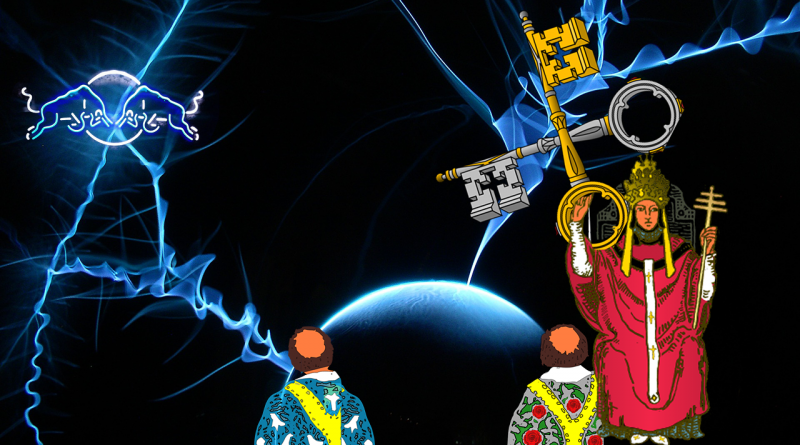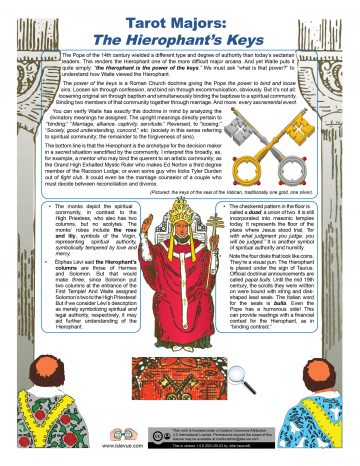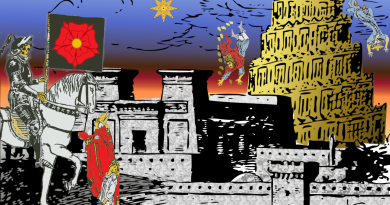The Power of the Keys
The fact is, whether we say Hierophant or Pope, toe-may-toe or toe-mah-toe, the fifth major arcanum is probably one of the most difficult for people of our day to relate to.
There is an essential tension between the Hierophant and the Pope of today: the papacy has shrunk in the centuries since the beginning of tarot, but the archetype underlying the card has not. This article will focus on the approaches one might take in interpretation to compensate for the changes in the role of the Pope in every day life in recent centuries.
I confess that I have sometimes felt hazy as to what the Hierophant is all about. At one moment, it seems to be a half-alive authoritarian, antithetical to soaring spiritual thought. At other times, a milque-toast, liable to be taken advantage of by those falsely seeking charity.
The post continues a format—one page, one basic thought —depicting a single aspect of a single major arcanum. So much has already been written about each of the major arcana, I see no need for me to repeat the general literature.
Where I think I have been most successful in the posts at this site is linking Tarot’s “building blocks” together and portraying them graphically (as in the Tarot Wheel and the One Page Guides) so as to better explain the whole. Therefore the format centers around a graphic, sometimes just the card itself, that sheds light on a single factor that helps make that arcanum what it is, along with (hopefully) a brief amount of text. Note the higher quality PDF download (free registration/confirmation required) will be easier to read than the bitmap above. Note also that the text on this page expands upon the text in the PDF plus adds a few links.
The Incredible Shrinking Pope
In fact, Waite tells us in the Pictorial Key to the Tarot exactly how he wants those who use his deck to understand the Hierophant:
Grand Orient says truly that the Hierophant is the power of the keys.
Unfortunately, this statement is not only obscured among a recounting of declarative statements approved or disapproved, but most especially by Waite having quoted himself under his former pseudonym of Grand Orient. It’s easy to overlook. I know I did, at least until fairly recently. But we shall recognize the weight and importance of this short statement as soon as we recognize it as the organizing principle for the divinatory meanings Waite assigned this card.
First, though, we must understand what the power of the keys is.
This "power of the keys" directly references a Roman Church doctrine that states the Pope has the power to bind and loose sins. It even has its own Wikipedia page, it’s that important. The doctrine itself is based upon a passage in the new testament.
The doctrine has been expanded to justify teaching, interpretation and so forth, and there are ties to the Holy Ghost, since the power was delegated on Pentecost (I’m surprised Waite didn’t work the infinity sign/lemniscate in, which he ascribes to the Holy Ghost. He usually overloads the symbols and is rarely subtle!). The binding and loosening, however, is by far the most important aspect. Non-Catholics, bear with us a moment: we want to establish that these "bindings" and "loosenings" can cover the entirety of a life:
- The clergy can bind a person to the spiritual community through baptism, or loosen them through excommunication.
- The clergy can loosen the burden of original sin through baptism.
- The clergy can loosen a sin through confession.
- The clergy can bind a couple to themselves and the spiritual community through marriage.
- The clergy can bind a young person to adulthood through confirmation.
- The clergy can loosen a person from this world through extreme unction.
Taken together, we could say that the doctrine of the power of the keys is the reach of the Pope’s spiritual authority into every sacred event within the lives of the members of the spiritual community.
You can verify that Waite had exactly this doctrine in mind by looking at the divinatory meanings he assigned. The upright meanings pertain to the "binding:" "Marriage, alliance, captivity, servitude." Reversed, pertaining to the "loosing:" "Society, good understanding, concord," etc. (society in this sense referring to the power of the Pope over church membership; the remainder to the forgiveness of sins).
But then… "what if the querent isn’t Catholic? They’re hardly going to submit to the Pope!" It doesn’t have to be the Pope. Most everyone who queries the cards has some relationship with a spiritual group. Or any creative group. For instance, for someone querying whether to study creative writing at school rather than a pre-M.B.A. course, the Hierophant can represent a mentor to be encountered who will bind the querent to an artistic community, a spiritual society of poets, if you will.
Anybody can be a spiritual mentor in any given situation. The bottom line is that the Hierophant is the archetype for the decision maker in a sacred situation sanctified by the community. I interpret this broadly, as, for example, a mentor who may bind the querent to an artistic community; as the Grand High Exalted Mystic Ruler who makes Ed Norton a third degree member of the Raccoon Lodge; or even some guy who kicks Tyler Durden out of fight club. It could even be the marriage counselor of a couple who helps them decide between reconciliation and divorce.
The two kneeling monks at the feet of the Pope are very important. They illustrate the community. Compare this to the High Priestess. She also has two columns, but no acolytes. Note that the monks’ robes include the rose and lily, the symbols of the Virgin Mary. Thus, spiritual authority is symbolically tempered with love and mercy.
Éliphas Lévi said the Hierophant’s columns are those of Hermes and Solomon. But that would make three, since Solomon put two columns at the entrance of the First Temple! Not to mention Waite already assigned them to the High Priestess! But if we consider Lévi’s description as merely symbolizing spiritual and legal authority, respectively, it may aid further understanding of the Hierophant.
Community need not be limited to a large group of people. The Hierophant also applies to the milestone events of a couple. For example, to an event such as the forgiveness by one married partner of the other for a grave wrong. Such events do have a degree of ceremony which may be well represented by the spiritual authority of the Hierophant. In fact, some of the early Church fathers extend the power of the keys such that it is said that we on Earth have the power to bind and loose on a personal basis. Of course, that may simply be a way of saying that "to forgive and forget" is divine.
The checkered pattern on the platform is called a duad, a union of two. It is still incorporated into masonic temples today. It is said to represent the floor of the place where Jesus stood trial, "for with what judgment you judge, you will be judged." It is another symbol of spiritual authority and humility (though that particular bible quote is from the sermon on the mount, not a trial).
From my own previous experience, the Hierophant can provoke a "Huh?" moment when the question or situation is primarily one of work or finances. Note the four disks that look like coins. They’re a visual pun. The Hierophant is placed under the sign of Taurus, the astrological house of money. Official doctrinal pronouncements are called papal bulls. Recall that we mentioned that the power of the keys (supposedly) gives support to the Pope’s ability to determine doctrine. Until the mid 19th century, the scrolls on which these doctrinal pronouncements were written on were bound with string and disk-shaped lead seals. The Italian word for the seals is bulla. Even the Pope has a humorous side!
In any case, the link with Taurus the Bull can provide readings with a financial context for the Hierophant, as in "binding contract." Thus, the Hierophant can represent some person who provides some authoritative guidance in financial matters, should that be the type of situation being considered. Mind you, I would have assigned the Hierophant to the classical element of Earth (to remind that Peter, the first Pope, was the "rock" upon which the Church was founded).
There is good reason to believe that other writers have recognized the power of the keys before me. I don’t claim that this is Earth shattering news. I even note that it appears that something like a single bulla is incorporated into the Camoin version of the Tarot de Marseilles’ Pope, but it is difficult to tell whether that is the intention, for sure. Pre-Camoin images do not appear to include it. Assuming that the bulla originate with Waite and Colman Smith, it would be interesting to know which one introduced the idea (given that Colman Smith converted to Catholicism, but Waite was said to be particularly concerned with the majors). But I’m not expecting an infallible papal bull to let us know one way or the other.
Copyright Information: This article’s content by John Iacovelli, for islevue.com is licensed under a Creative Commons Attribution 4.0 International License. Permissions beyond the scope of this license may be available at mailto:admin@islevue.com.
This article’s content by John Iacovelli, for islevue.com is licensed under a Creative Commons Attribution 4.0 International License. Permissions beyond the scope of this license may be available at mailto:admin@islevue.com.
Background art of the feature image by Willi Heidelbach from Pixabay




